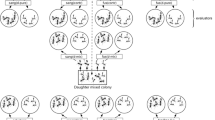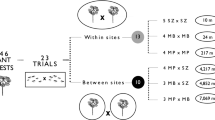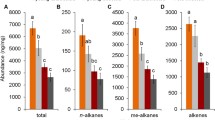Abstract
Colonies of the slave-making ant, Harpagoxenus sublaevis, may simultaneously contain workers of several Leptothorax slave species. We observed aggressive interactions among slave-makers, between slavemakers and slaves, and among slaves in 11 mixed colonies. The first two types of aggression appear to be correlated with reproductive competition for the production of males. Aggressive interactions among slaves, however, occurred mainly between slaves belonging to different species. In two colonies, in which one slave species clearly outnumbered the other, the majority attacked and finally expelled all nestmates belonging to the minority species. Our observations thus suggest that in Harpagoxenus colonies a homogeneous “colony odor” is not always achieved and that heterospecific slaves may occasionally be mistaken for alien ants. Gas chromatographic analyses of ants from mixed colonies similarly show that cuticular hydrocarbon profiles may differ strongly between heterospecific nestmate slaves.
Similar content being viewed by others
References
Altmann J (1974) Observational study of behavior: sampling methods. Behaviour 49:227–267
Bonavita-Cougourdan A, Clément J-L, Lange C (1989) The role of cuticular hydrocarbons in recognition of larvae by workers of the ant Camponotus vagus: changes in the chemical signature in response to social environment (Hymenoptera: Formicidae). Sociobiology 16:49–74
Bourke AFG (1988) Dominance orders, worker reproduction, and queen-worker conflict in the slave-making ant Harpagoxenus sublaevis. Behav Ecol Sociobiol 23:323–333
Buckle GR, Greenberg L (1981) Nestmate recognition in sweat bees (Lasioglossum zephyrum): does an individual recognize its own odour or only odours of its nestmates? Anim Behav 29:802–809
Buschinger A (1966) Untersuchungen an Harpagoxenus sublaevis Nyl. (Hym., Formicidae). I. Freilandbeobachtungen zu Verbreitung und Lebensweise. Insectes Soc 13:5–16
Buschinger A (1974) Experimente und Beobachtungen zur Gründung and Entwicklung neuer Sozietäten der sklavenhaltenden Ameise Harpagoxenus sublaevis (Nyl.). Insectes Soc 21:381–406
Buschinger A, Alloway TM (1978) Caste polymorphism in Harpagoxenus canadensis M.R. Smith (Hym., Formicidae). Insectes Soc 25:339–350
Buschinger A, Winter U (1978) Echte Arbeiterinnen, fertile Arbeiterinnen and sterile Wirtsweibchen in Völkern der dulotischen Ameise Harpagoxenus sublaevis (Nyl.) (Hym., Form.). Insectes Soc 25:63–78
Buschinger A, Ehrhardt W, Winter U (1980) The organization of slave raids in dulotic ants — a comparative study (Hymenoptera; Formicidae). Z Tierpsychol 53:245–264
Buschinger A, Ehrhardt W, Fischer K, Ofer J (1988) The slavemaking ant genus Chalepoxenus (Hymenoptera, Formicidae). I. Review of literature, range, slave species. Zool Jb Syst 115:383–401
Carlin NF (1989) Discrimination between and within colonies of social insects: two null hypotheses. Neth J Zool 39:86–100
Carlin NF, Hölldobler B (1983) Nestmate and kin recognition in interspecific mixed colonies of ants. Science 222:1027–1029
Carlin NF, Hölldobler B, Gladstein DS (1987) The kin recognition system of carpenter ants (Camponotus spp.). III Withincolony discrimination. Behav Ecol Sociobiol 20:219–227
Crozier RH, Dix MW (1979) Analysis of two genetic models for the innate components of colony odor in social Hymenoptera. Behav Ecol Sociobiol 4:217–224
Dobrzański J (1966)Contribution to the ethology of Leptothorax acervorum (Hymenoptera: Formicidae). Acta Biol Exper 26:71–78
Errard C, Jaisson P (1991) Les premiéres étapes de la reconnaissance interspécifique chez les fourmis Manica rubida et Formica selysi (Hymenoptera, Formicidae) élevées en colonies mixtes. CR Acad Sci Paris Sér III 313:73–80
Errard C, Bagnéres AG, Clément JL (1989) Les signaux chimiques de la reconnaissance interspécifique chez les fourmis. Actes Coll Insectes Soc 5, 285–292
Fielde AM (1903) Artificial mixed nests of ants. Biol Bull Mar Biol Lab Woods Hole 5:320–325
Franks N, Blum M, Smith R-K, Allies AB (1990) Behavior and chemical disguise of cuckoo ant Leptothorax kutteri in relation to its host Leptothorax acervorum. J Chem Ecol 16:1431–1444
Goodloe L, Sanwald R, Topoff H (1987) Host specificity in raiding behavior of the slave-making ant Polyergus lucidus. Psyche 94:39–44
Greenberg L (1979) Genetic component of bee odor in kin recognition. Science 206:1095–1097
Habersetzer C (1993) Cuticular spectra and inter-individual recognition in the slave-making ant Polyergus rufescens and the slave species Formica rufibarbis. Physiol Entomol 18:167–175
Habersetzer C, Bonavita-Cougourdan A (1993) Cuticular spectra in the slave-making ant Polyergus rufescens and the slave species Formica rufbarbis. Physiol Entomol 18:160–166
Hamilton WD (1964) The genetical evolution of social behaviour. J Theor Biol 7:1–52
Heinze J, Stuart RJ, Alloway TM, Buschinger A (1992) Host specificity in the slave-making ant Harpagoxenus canadensis M.R. Smith. Can J Zool 70:167–170
Hölldobler B (1973) Zur Ethologie der chemischen Verständigung bei Ameisen. Nova Acta Leopold 37:259–292
Hölldobler B (1977) Communication in social Hymenoptera. In: Sebeok TA (ed) How animals communicate. Indiana University Press, Bloomington, 418–471
Hölldobler B, Michener CD (1980) Mechanisms of identification and discrimination in social Hymenoptera. In: Markl H (ed) Evolution of social behavior: hypotheses and empirical tests. Chemie, Weinheim, 35–58
Hölldobler B, Wilson EO (1990) The ants. Belknap, Cambridge
Hung AC (1973) Reproductive biology in dulotic ants: preliminary report (Hymenoppera: Formicidae). Entomol News 84:253–259
Jaisson P (1975) L'imprégnation dans l'ontogénése des comportements de soins aux cocons chez la jeune fourmi rousse (Formica polyctena Först.). Behaviour 52:1–37
Kaib M, Brandl R, Bagine RKN (1991) Cuticular hydrocarbon profiles: A tool in termite taxonomy. Naturwissenschaften 78:176–179
Kaib M, Heinze J, Ortius D (1993) Cuticular hydrocarbon profiles of adults and pupae in the slave-making ant Harpagoxenus sublaevis and its hosts. Naturwissenschaften 80:281–285
Le Moli F, Mori A (1987) The problem of enslaved ant species: origin and behavior. In: Pasteels JM, Deneubourg J-L (eds) From individual to collective behavior in social insects. Birkhäuser, Basel, 333–363
Morel L, Vander Meer RK, Lavine BK (1988) Ontogeny of nestmate recognition cues in the red carpenter ant (Camponotus foridanus): behavioral and chemical evidence for the role of age and social experience. Behav Ecol Sociobiol 22:175–183
Nowbahari E, Lenoir A, Clément JL, Lange C, Bagnéres AG, Joulie C (1990) Individual, geographical and experimental variation of cuticular hydrocarbons of the ant Cataglyphis cursor (Hymenoptera: Formicidae): their use in nest and subspecies recognition. Biochem Syst Ecol 18:63–73
Obin MS (1986) Nestmate recognition cues in laboratory and field colonies of Solenopsis invicta Buren (Hymenoptera: Formicidae). J Chem Ecol 12:1965–1975
Ortius D (1992) Untersuchung zur sozialen Struktur unter den Sklaven in gemischten Kolonien von Harpagoxenus sublaevis. Unpublished Diploma-thesis, Julius-Maximilians-Universität, Würzburg
Rohlf FJ (1990) NTSYS-pc. Numerical taxonomy and multivariate analysis systems. Exeter, New York
Sachs L (1984) Angewandte Statistik. 6th edn., Springer, Berlin Heidelberg New York
Schumann R, Buschinger A (1991) Selective acceptance of alien host species pupae by slaves of the dulotic ant, Harpagoxenus sublaevis (Hymenoptera, Formicidae, Myrmicinae). Ethology 88:154–162
Sokal RR, Rohlf FJ (1987) Introduction to biostatistics. Freeman, New York
Stuart RJ (1988a) Development and evolution in the nestmate recognition systems of social insects. In: Greenberg G, Tobach E (eds) Evolution of social behavior and integrative levels Lawrence Erlbaum, Hillsdale, pp. 177–195
Stuart RJ (1988b) Collective cues as a basis for nestmate recognition in polygynous leptothoracine ants. Proc Natl Acad Sci USA 85:4572–4575
Stuart RJ (1992) Nestmate recognition and the ontogeny of acceptability in the ant, Leptothorax curvispinosus. Behav Ecol Sociobiol 30:403–408
Vienne C, Errard C, Lenoir A (1992) Spatial organization & nestmate recognition in artifical mixed colonies of Manica rubida and Myrmica rubra (Hymenoptera: Formicidae). Sociobiology 20:1–16
Wilson EO (1955) Division of labor in a nest of the slave-making ant Formica wheeleri Creighton. Psyche 62:130–133
Wilson EO (1971) The insect societies. Belknap, Cambridge
Yamaoka R (1990) Chemical approach to understanding interactions among organisms. Physiol Ecol Jpn 27:31–52
Author information
Authors and Affiliations
Rights and permissions
About this article
Cite this article
Heinze, J., Ortius, D., Kaib, M. et al. Interspecific aggression in colonies of the slave-making ant Harpagoxenus sublaevis . Behav Ecol Sociobiol 35, 75–83 (1994). https://doi.org/10.1007/BF00171496
Received:
Accepted:
Issue Date:
DOI: https://doi.org/10.1007/BF00171496




